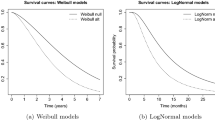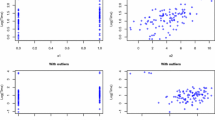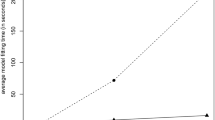Abstract
Semiparametric transformation models for failure time data consist of a parametric regression component and an unspecified cumulative baseline hazard. The nonparametric maximum likelihood estimator (NPMLE) of the cumulative baseline hazard can be summarized in terms of weights introduced into a Breslow-type estimator (Weighted Breslow). At any given time point, the weights invoke an integral over the future of the cumulative baseline hazard, which presents theoretical and computational challenges. A simpler non-MLE Breslow-type estimator (Breslow) was derived earlier from a martingale estimating equation (MEE) setting observed and expected counts of failures equal, conditional on the past history. Despite much successful theoretical and computational development, the simpler Breslow estimator continues to be commonly used as a compromise between simplicity and perceived loss of full efficiency. In this paper we derive the relative efficiency of the Breslow estimator and consider the properties of the two estimators using simulations and real data on prostate cancer survival.





Similar content being viewed by others
References
Almudevar A, Oakes D, Hall J (2020) Statistical modeling for biological systems. In: Memory of Andrei Yakovlev, Springer, New York
Andersen P, Gill R (1982) Cox’s regression model for counting processes: a large sample study. Ann Stat 10:1100–1120
Breslow N (1972) Discussion on Regression models and life tables. J Roy Stat Soc: Ser B (Methodol) 34:216–217
Chen K, Jin Z, Yin Z (2002) Semiparametric analysis of transformation models with censored data. Biometrika 89:659–668
Chen Y (2009) Weighted Breslow-type and maximum likelihood estimation in semiparametric transformation models. Biometrika 96:591–600
Cox D (1972) Regression models and life tables. J Roy Stat Soc: Ser B (Methodol) 34:187–200
Fleming T, Harrington D (1991) Counting processes and survival analysis. Wiley, Hoboken
Hu C, Tsodikov A (2014) Semiparametric regression analysis for time-to-event marked endpoints in cancer studies. Biostatistics 15:513–525
Kosorok M (2008) Introduction to Empirical Processes and Semiparametric Inference. Springer, New York
Kosorok M, Lee B, Fine J (2004) Robust inference for univariate proportional hazards frailty regression models. Ann Stat 32:1448–1491
Murphy S, van de Vaart A (2000) On profile likelihood. J Am Stat Assoc 95:449–465
Rice J, Tsodikov A (2017) Semiparametric time-to-event modeling in the presence of a latent progression event. Biometrics 73:463–472
Tsiatis A (1981) A large sample study of Cox’s regression model. Ann Stat 9:93–108
Tsodikov A (2003) Semiparametric models: a generalized self-consistency approach. J Roy Stat Soc: Ser B (Methodol) 65:759–774
van der Vaart A, Wellner J (1996) Weak convergence and empirical processes: with applications to statistics. Springer, New York
Zeng D, Lin D (2006) Efficient estimation of semiparametric transformation models for counting processes. Biometrika 93:627–640
Zeng D, Lin D (2007) Maximum likelihood estimation in semiparametric regression models with censored data (with discussion). J Roy Stat Soc: Ser B (Methodol) 69:507–564
Zucker D (2005) A pseudo-partial likelihood method for semiparametric survival regression with covariate errors. J Am Stat Assoc 100:1264–1277
Funding
This work was supported by methodological grants from the National Cancer Institute’s Division of Cancer Control and Populations Sciences’ (DCCPS) portfolio in statistical and analytic methods, 1R01CA242559, and 1U01CA253915 (Cancer Interventions Surveillance Modeling Network, CISNET).
Author information
Authors and Affiliations
Corresponding author
Additional information
Publisher's Note
Springer Nature remains neutral with regard to jurisdictional claims in published maps and institutional affiliations.
Supplementary Information
Below is the link to the electronic supplementary material.
Rights and permissions
Springer Nature or its licensor (e.g. a society or other partner) holds exclusive rights to this article under a publishing agreement with the author(s) or other rightsholder(s); author self-archiving of the accepted manuscript version of this article is solely governed by the terms of such publishing agreement and applicable law.
About this article
Cite this article
Devasia, T.P., Tsodikov, A. Efficiency of the Breslow estimator in semiparametric transformation models. Lifetime Data Anal 30, 291–309 (2024). https://doi.org/10.1007/s10985-023-09611-w
Received:
Accepted:
Published:
Issue Date:
DOI: https://doi.org/10.1007/s10985-023-09611-w




